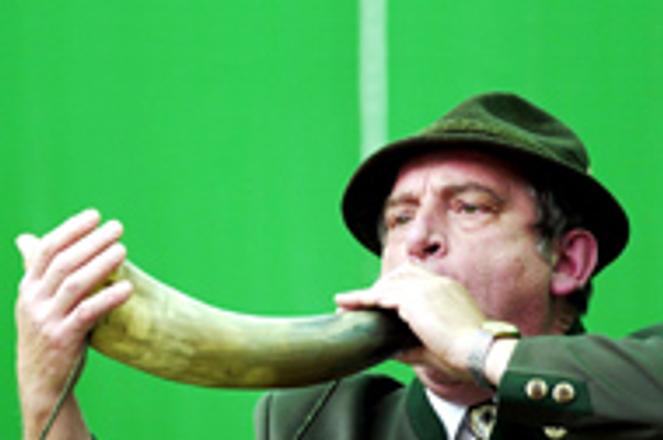A DEER caller at the Days of St Hubert, a national meeting of hunters every September at St Anton.photo: TASR
REGIONAL game commissions meet each year at the beginning of March to evaluate the seasonal hunting results. Deer antlers and boar tusks are measured and weighed, and the breeding results compared with those of previous years. This all happens behind doors closed to public, but when the doors open, the public sees the results at exhibitions held around the country.
One such exhibition mapping the results of the 2003 hunting season opened on March 10 at the Museum of Hungarian Culture and the Danube Area in the southern Slovak town of Komárno. Another was scheduled to open on Sunday, March 14, at the Svätý Anton Chateaux in central Slovakia.
"The exhibitions are evidence of the breeding success of hunters, who take care of these animals year-round, mainly during the winter. Their care is reflected in the beauty, the quality of the animals' antlers. These displays, I can say, are the harvest of the hunting season," said Erik Petrikovič from the hunting department of the Svätý Anton Chateaux.
Slovakia has hundreds of game areas and up to 50,000 hunters. There are hilly areas in central and northern Slovakia mainly inhabited by deer and rams, and lowlands in the country's south with wild boars, rabbits, and pheasants. The diversity in living conditions for game plays a role in how the trophies are evaluated. For example, the middle, or lowlands have milder criteria for appraising deer antlers than the high-mountainous areas, which are the natural home of these species.
The exhibition of hunting trophies in the Komárno museum features 182 roe deer, two deer, and one ram, along with taxidermic displays of wild boars and the processed furs of pests, such as fox. Organised in cooperation with the regional organisation of the hunting union, the exhibition is the first of its kind to be held at the museum since 1985, said its curator, Pál Binder.
The Regional Breeders' Exhibition of Trophies at the Svätý Anton Chateaux has been held annually for over 10 years. The international visitors, including hunters, that come to the show praise the diversity of the local Slovak fauna. This year's "harvest" consists of over 400 trophies of deer, roe deer, rams and boars, as well as displays of other animals hunted down in the region's districts of Banská Štiavnica, Žiar nad Hronom, and Žarnovica. A large percentage of the 177 hunted deer were awarded: 16 with bronze, four with silver, and one with a gold medal. There was one gold winner among the rams and boars, and several silver and bronze awards.
THE RESULTS of good care.photo: Ján Svrček
"The quality of the trophies in the deer category has generally increased [throughout Slovakia]. When talking specifically about roe deer, however, the situation is unfortunately quite the contrary. Roe deer trophies are getting worse [an exeption might be the Komárno area, with three gold and four silver medals - ed.note]. Good results can also be seen in ram and boar game," Petrikovič said.
Slovakia is a mountainous country and its hunters, who have always worked as the prime protectors of the game environment, have managed to save species threatened by extinction. Such was the case with the brown bear in the 1930s. Today, the problem with bears is quite the opposite: over-breeding, which is also the case with wolves. Another animal that the hunters managed to save is the lynx, which is extinct in many other places.
"Game hunting is not, as many people think, only about killing. In fact, this is the last thing that a hunter does. Each person who owns a hunting area carefully plans the number of animals that can be shot according to certain criteria. No good cultivator would shoot out his 'larder' all at once; he has to first assure its regeneration. [A hunter] has to carefully select their number, as there aren't enough predators in nature," said Petrikovič.
WHAT: Hunting Trophies.
WHEN: running Tue-Sat, 9:00-16:00 until March 24.
WHERE: Museum of Hungarian Culture and the Danube area, Palatínova 13, Komárno.
Tel: 035/7731-476.
WHAT: The Regional Breeders' Exhibition of Trophies 2003.
WHEN: running Tue-Sat, 8:00-15:00 until March 28.
WHERE: Svätý Anton Chatea-ux, (near Banská Štiavnica).
Tel: 045/6913-932.
The Levice Hunting Days international conference will run from March 25 to April 2, 2004, discussing the situation of smaller game, such as pheasants and rabbits. The conference will be attended by various international experts presenting their results and seeking solutions to preserve diversity in the fauna world.
For more information on the museums and their exhibitions, visit www.muzeum.sk.


